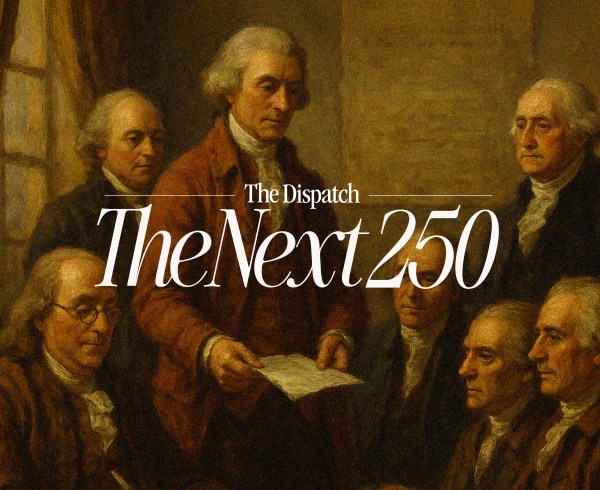Happy Thursday! Your Morning Dispatch team saw one another in person yesterday (outdoors, socially distanced) for the first time since March. Nice to remember we’re more than disembodied heads and shoulders on Zoom calls!
Quick Hits: Today’s Top Stories
-
The United States confirmed 39,657 new cases of COVID-19 yesterday per the Johns Hopkins University COVID-19 Dashboard, with 5.1 percent of the 784,478 tests reported coming back positive. An additional 914 deaths were attributed to the virus on Wednesday, bringing the pandemic’s American death toll to 206,888.


-
The Senate voted 84-10 to approve the stopgap spending bill passed by the House last week that will avert a government shutdown, funding the federal government through the general election into early December. President Trump signed the legislation shortly after midnight.
-
Just more than 73 million people tuned in to Tuesday night’s presidential debate on television per Nielsen ratings, a 13 percent decrease from the 84 million who watched Donald Trump and Hillary Clinton’s first debate in 2016. Millions more likely streamed the debate online or watched clips on social media, but such data are elusive.
-
The Commission on Presidential Debates is weighing changes to the debate format after the tumultuous exchanges between President Trump and Democratic nominee Joe Biden. “Last night’s debate made clear that additional structure should be added to the format of the remaining debates to ensure a more orderly discussion of the issues,” it said in a statement. “The CPD will be carefully considering the changes that it will adopt and will announce those measures shortly.”
-
California Gov. Gavin Newsom signed a series of policing bills on Wednesday that will ban chokeholds, require the state’s attorney general to investigate all fatal police shootings of unarmed individuals, and reform California’s probation and juvenile justice systems.
-
House Democrats will reportedly urge Congress to curb the power of large technology companies after a 15-month investigation by the Antitrust Subcommittee into Google, Apple, Facebook, and Amazon.
Ohio: A Swing State Once Again

After the debate in Cleveland on Tuesday night, CNN conducted a focus group of 14 undecided Ohio voters to gauge how the event played in what is shaping up to be one of the most important states in the presidential election. Only three of the 14 voters believed one candidate stood out over the other on the debate stage—a microcosmic view of the neck-and-neck race in Ohio as a whole.
Neck-and-neck in Ohio is bad news for Trump. Of the four Rust Belt states he flipped four years ago—Michigan, Pennsylvania, Wisconsin, and Ohio—Ohio was by far his most decisive victory. The Buckeye State went blue in both 2008 and 2012—by 4.6 and 3 points, respectively—but Trump won it by 8.1 points in 2016 on his way to sweeping the Midwest (save Illinois and Minnesota) and taking the White House. In Michigan he won by 0.2 points; in Pennsylvania and Wisconsin he won by 0.7.

To be in a statistical tie with Joe Biden in Ohio 33 days out, therefore, is less than ideal for the president’s re-election chances. A recent Quinnipiac University poll had the former vice president up 1 point in the state; a Fox News poll had him up 5. Biden doesn’t even need Ohio—he has multiple other pathways to get the necessary 270 electoral votes. But for Trump, losing it would almost certainly be a death knell.

So why have we heard so much about Florida, Pennsylvania, and Arizona but almost nothing about Ohio? Trump’s large margin of victory four years ago may have led Democrats to write off the state and Republicans to become complacent. “Part of the reason why it just has not gotten the attention it normally has, is that there’s sort of an intimidation factor,” said Amy Walter of the Cook Political Report.
“When you actually look at the numbers [from 2016], what you see is that Donald Trump got a little over 51 percent,” Walter told The Dispatch. That’s enough to win, obviously, but not the smashing victory that an 8-point margin might imply. Nearly 5 percent of the state’s vote went to third-party candidates or write-ins. The 2018 gubernatorial race should have been a warning to Republicans that Trump’s dominance in the state may have been fleeting: Mike DeWine beat his Democratic opponent, Richard Cordray, by just 3.7 points.
What explains the shift? Suburbs. Although suburban voters in Ohio were largely left out of the national suburban Democratic shift in 2018, Walter said “that is no longer the case in 2020.” Coupled with Biden’s marginal improvement with non-college-degree white voters in more rural areas—which itself builds on gains with that group in Cordray’s failed 2018 run for governor and Sen. Sherrod Brown’s successful re-election campaign that same year—Ohio has suddenly, quietly, become a real pick-up opportunity for Democrats.
“If Ohio were to flip, it would probably be part of a fairly significant rejection of the president nationally,” said Kyle Kondik, an elections analyst at the University of Virginia’s Center for Politics and author of The Bellwether: Why Ohio Picks the President. Ohio’s small non-white population and high percentage of whites without a college degree (the much-discussed “white working class”) rendered it 10 points to the right of the nation in 2016. A Trump loss in Ohio would almost certainly mean losses across the rest of the Rust Belt and a large Electoral College defeat.
All that said, Ohio remains unlikely to become a focal point for either campaign over the next 30 days. While necessary for Trump’s re-election, Ohio “would be more like Biden’s 340th or 350th Electoral College vote” in the event of Democratic victory, Dave Wasserman of Cook Political Report told The Dispatch. The Trump campaign “can’t play whack-a-mole by trying to fix problems in states that ought to be red and then move on to states that are purple,” he continued. The president can only hope to bring Ohio back into the solidly Republican column by improving his national standing, a prospect that looks less likely by the day.
A Biden win in Ohio, Walter noted, would “argue against so much of the conventional wisdom post-2016” that the Democratic future lies in running up bigger margins with suburban and non-white voters. The state that swung most heavily for Trump in 2016 flipping again four years later could suggest to both parties that the political realignment of the past four years is far less cemented than experts on either side assume.
Another Note on Schools and COVID-19
In assessing U.S. schools’ fight to contain COVID, one major difficulty is that schools’ decentralized governance and myriad different reporting structures make it difficult to find general data in real time. Earlier this week, we talked briefly about one effort to address this problem: Brown University’s COVID-19 School Response Dashboard, a new public health effort compiling several types of infection information from schools around the country in a format that’s easy to grasp at a glance.
The dashboard reported its most recent two weeks of data on Wednesday, showing that—despite rising COVID cases in many communities around the country—schools are still largely holding steady—and low. Compared to the first two weeks of September, staff confirmed and suspected COVID infection rates crept up from 0.5 percent to about 0.6 percent. Meanwhile, the rate for students confirmed and suspected inched down from 0.2 percent to 0.16 percent.
Local news stories continue to bubble up about outbreaks at reopening schools. What remains to be seen—and what will matter in the end, as a matter of policy—is not whether the virus is showing up among people attending schools, but whether it is spreading at schools. Efforts like the Brown University dashboard will hopefully give us insight into questions like these in the weeks ahead.
Worth Your Time
-
Ever since FiveThirtyEight launched its general election polling averages on June 18, Joe Biden has led Trump by at least 6.8 points nationally. But despite the Democratic nominee’s steady advantage, survey respondents tend to think both candidates have an equal chance of winning in November. Part of this hinges on voters’ focus on battleground states. “If we look at potential tipping-point states, the race is a bit closer, but not that much closer,” writes FiveThirtyEight elections analyst Nate Silver. He breaks down the top three sources of election anxiety among Biden supporters: How likely is it that Trump wins the Electoral College but loses the popular vote by a wide margin? What if the polls are wrong? Can Trump actually steal the election?
-
Sarah Longwell has conducted hundreds of focus groups with Trump voters over the past few years, honing in on female swing-state voters in particular. She checked in with nine of them after Tuesday night’s debate: “There’s no sugar-coating it: Whatever Donald Trump was trying to do last night backfired with this group spectacularly.” Here’s what one woman in Texas—who went into the night planning to vote for Trump—said: “I don’t know if I am going to stick with him. That was awful last night. I’m moving more towards the fence, I really am. It was despicable behavior, the way he attacked Joe’s sons, one of whom is dead, it was terrible.”
-
In a piece for TheAtlantic, Derek Thompson debunks the myths and conspiracy theories surrounding voter fraud while acknowledging the risks that the surge in mail-in-voting presents to this election season. (For a terrific read on the latter, please see Sarah’s analysis in The Sweep from back in early August.) Thompson writes: “Mail votes are more convenient, but more easily disqualified,” he writes. “They are more error-prone, but not statistically fraudulent; they are more likely to expand the electorate, but at the cost of increasing the total number of rejected ballots.” More than 550,000 absentee and mail-in ballots were disqualified during the 2020 primary season, a startling figure that should keep election officials on high alert as we inch ever closer to November 3rd. Since Democrats are far more likely than Republicans to vote by mail, Joe Biden is in a bit of a conundrum: “Democrats’ big edge in early voting and mail votes might be a salutary achievement,” Thompson writes. “But in a close election, the combination of innocent mistakes by voters, mass litigation in close states, and conspiracy theories about mail-in voting could create the mother of all electoral headaches.”
Presented Without Comment
Toeing the Company Line
-
As Sarah reminds us on yesterday’s Dispatch Podcast, presidential candidates go into debates with a strategy, basing their metric of success on their ability to boost turnout within a pre-existing base. Did either presidential candidate achieve what they wanted to during Tuesday’s debate? Are undecided voters who tuned in now more or less likely to show up to the polls? After a post-debate recap, Sarah and the guys also discuss the electoral and national security implications of the New York Times’ report on Trump’s tax returns, and DNI John Ratcliffe’s letter to Sen. Lindsey Graham making public unverified raw intelligence from Russia just weeks before the election.
-
David watched Tuesday night’s debate, and he saw a bully. “One can legitimately hold his [Biden’s] feet to the fire on taxpayer support for abortion, for the stunning concessions in the Iran deal, and for the Obama administration’s failures in Iraq and Syria—failures that led not just to the rise of ISIS but also to the reinsertion of American ground troops and the expansion of Middle East wars,” he writes in his latest French Press (🔒). “Trump charts a different path—one that relegates substance to the dark corners of the stage and puts style at the very center. And that style is the chaotic, performative, and swaggering toughness of the bully …”
-
On the site today, Christian Schneider predicts that even if Donald Trump loses in November, some things will not go back to normal. He suggests that political parties, local politics, Congress, and the media have all been subject to changes that will be hard to reverse.
-
Also, Dalibor Rohac looks at the populist authoritarians to whom Trump has been compared, and decides that there is not much populist about Trump. “And even if he wins again in November, it will be thanks to the peculiarities of the Electoral College—not because he would have an unequivocal majority of Americans behind him. That does not make his election illegitimate, as some on the left suggest, but it does make him an odd tribune of America’s supposedly voiceless majority.”
Let Us Know
If you were the Commission on Presidential Debates, what changes would you implement to improve the quality of the next debate?
Reporting by Declan Garvey (@declanpgarvey), Andrew Egger (@EggerDC), Charlotte Lawson (@charlotteUVA), Audrey Fahlberg (@FahlOutBerg), James P. Sutton (@jamespsuttonsf), and Steve Hayes (@stephenfhayes).
Photograph by Alex Wong/Getty Images.







Please note that we at The Dispatch hold ourselves, our work, and our commenters to a higher standard than other places on the internet. We welcome comments that foster genuine debate or discussion—including comments critical of us or our work—but responses that include ad hominem attacks on fellow Dispatch members or are intended to stoke fear and anger may be moderated.
With your membership, you only have the ability to comment on The Morning Dispatch articles. Consider upgrading to join the conversation everywhere.